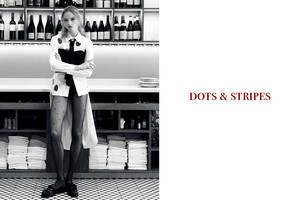TALKING SUSTAINABILITY AND TECH WITH AMANDA PARKES
Written by Ksenia RundinFashion, digitalization and sustainability are connecting people more frequently today than ever before. Everyone is concerned about how the future will look like and where our consumption will carry us. Amanda Parkes has her scientific and industrial meanings around sustainability, high-tech textiles, artificial intelligence and future of fashion as such. In May 2017 she stepped into the role of chief innovation officer at Fashion Tech Lab, founded by Miroslava Duma as a new hybrid venture that is part investment fund, accelerator and laboratory. In June Fashion Tech Talks invited Amanda Parkes to Stockholm as one of the speakers, where she shared her ideas about building a sustainable material culture and producing smart fibres. While attending the conference, Odalisque Magazine could have a thought-provoking interview with Amanda, asking her a few questions concerning different aspects of the future of fashion.
Could you please tell whether Future Tech Lab is a profit or non-profit organisation and what is your role in it?
It is a for-profit organisation. The company is designed to be kind of disruptive to the industry and to move it forward. One of the pillars is the investment fund which is a start-up within sustainable and innovative textiles and broad section of that moving interactively. The second pillar is the agency, where we work with clients, helping them with sustainable innovation strategy, as well as connecting them to start-ups. Thus, we are a bridge builder in that way. And we are also building a brand through our experimental labs, working on creating showcasing fashion products by using alternative and interesting sustainable textiles. My role is chief innovation officer, steering innovation processes across those three pillars, trying actually to be quite fluent with that, and I also do a lot of public speaking.
Do you think, we can reach the “zero-waste” goal by continuing to consume in the same way as we are doing now?
It is such a complicated question starting with asking what the definition of “zero waste” is and how you measure and analyse zero ability in general. It is kind of a part of the industry having to work together in order to really define those metrics and try to understand those, because what might be good and sustainable in one place is not the best solution in another place. In terms of the consumption aspects, I think, it is quite interesting to hear arguments on different sides. First of all, if we stay at the same level of consumption, while the population of the world is increasing, is that sustainable or not? The ideas behind justifying our levels of consumption and growth are about if everything is circular, and it is going back in, then you can sort of justify fast fashion. Personally, I do not think that this is a fantastic justification, and I think that it is really more about the value system. The very nature of fast fashion and how cheap it is, is what really drives the mass consumption, because people can afford it. It is based on not a sustainable premise, meaning that someone is paying the price, whether it would be the environment for using harmful materials or humanistic ideas. Great part of it is not directly about consumption. The idea of the close meaning between what costs more is also to be valued more, would potentially hurt the environment.
Isn’t that also a matter of ideology?
Exactly. One thing is that we will never get rid of the fact that people want to use fashion as a language for personal expression and as a way to create identity. We are not going to change the idea that people want newness in their lives. That is really the fact of the fashion and sort of a point of the latter. I think, from that angle we should not be trying to get rid of it. What we should do is different battles, where you can have newness that is not just a value of clothing, things like rental systems, sharing systems, reclaim. Just all those kinds of notions that look different to the models.
How do you think the notion of luxury might change due to the presence of artificial intelligence (AI). In particular, I am concerned about the aspect of heritage, when we today producing new things and later reproducing those, basing our references on them? Do you think the element of heritage can lose its actuality as a component of the luxury concept?
It is definitely not going to disappear. And even in the short term, AI is going to have very little effect on luxury, because there is a lot of AI predictive analyses saying that the latter is transitioning very rapidly, what is closely tight to fast fashion. Meanwhile, luxury has always been a kind of classic and scarce, when a brand for example makes a certain number of a particular bag model and people are hunting them. Hence, you are not really fighting access in this case. In an interesting way, luxury is actually quite sustainable, because the goods are certainly pretty expensive due to their good quality including arts and crafts. Thus, people can use them in a longer period of time. In this sense, luxury is very satisfying for the sustainability goals. However, potentially new materials might bring change into the concept of luxury also changing our way to view things like fur and leather. In the context of sustainability, it makes us reconsider the ecosystems around productions and materials. Is silk thread created of synthetic piles considered less valuable than the thread coming from a real spider? Where is a value system inside of that? What do people really care about in luxury? What is luxury with those new material? These things I find really interesting to discuss.
It is pretty clear today that we need AI to handle all that huge amount of data we are producing and collecting on daily basis. How do you think we can avoid a kind of Blade-Runner society and who should have control over all the information?
First of all, we need to differentiate between AI and algorithms that create the meaning among the data, because AI is really based on the supposition that it is trying to predict or know something. Whereas, if you are just talking about algorithms and the analyses of the data, what you want to be is neutral and unbiased. In the sense of having a data and analysis of what it means is of massive value. It is really a question with any new technology, when you have something, what you might call a “Wild West period”, before governments or any kind of legislator try to create any kind of policy. You can either have go-for-it attitude and see what people do and then create some laws in the back-end, what is much more destructive, or you can have a community itself with people, who are developing technology and be self-governing, saying, “Here is what we think we should be doing.” And, I think, the second alternative is something that is going a lot more in biotech in general, not just in the context of fashion and materials. I think, the people who are developing the technology are the best suited to create their own guiding rules. When decisions are to be made, I hope this is what will come in the place together with ethics, questioning not only the technical part but also asking why.
What do you personally think will happen to the industry of trendspotting in future and will the gut-feeling still matter?
Nevertheless, trendspotting is probably more about what people seeing on the streets. All the technology is actually about questioning what the humans are good at, what is very hard for machines to do. You can walk around the city and kind of scope the style of the city and get a feel for it. Would robots be able to do that? Even if it is a collection of photographs, there is something to be said about first of all physical attractiveness and trendspotting has a piece of that. And also an eye for style is one of the things that AI has not done right. When you look at two identical suits but one of them is luxury and one of them is very low quality, and you are able to see it. It could be about tiny tricks and cuts, what would be very hard to get for AI. You might get 95 percent with AI but the last five percent is the human eye and the essence of things. And also the creativity aspect is important here, because the influence trends have on us is not merely about science.













